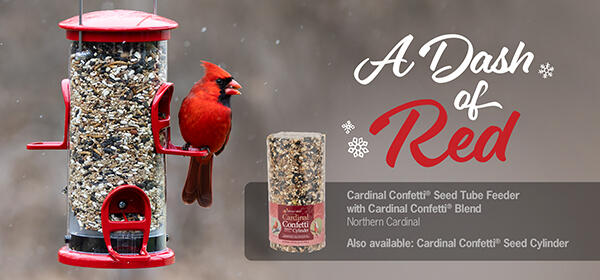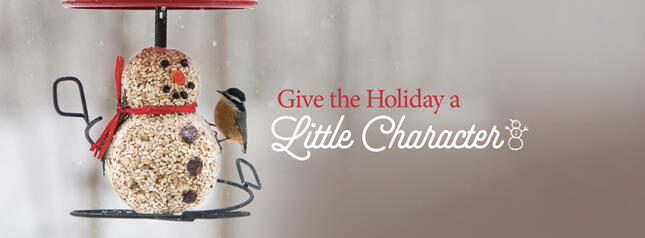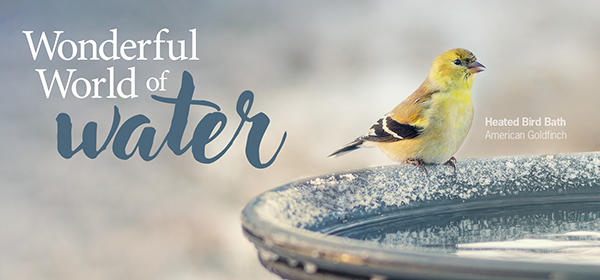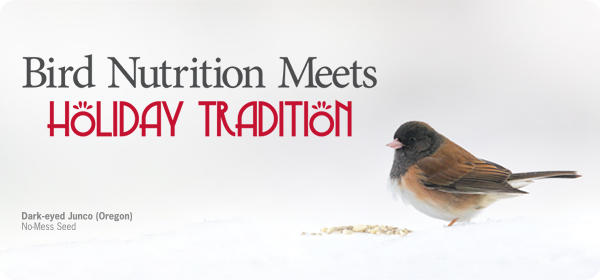Adjusted Store Hours
December 24th: Open 10am - 3pm
December 25th: CLOSED for Christmas Day
December 31st: Open 10am - 3pm
January 1st: CLOSED for New Year's Day

CARDINAL CONFETTI
Throw a party for your cardinals and we'll bring the confetti! Cardinal Confetti is a WBU exclusive product, sure to attract Northern Cardinals, Pyrrhuloxia and more. During testing more than 40 bird species were observed consuming the blend.
Holiday Traditions
Family traditions…in many ways these are what make the holidays so highly anticipated and uniquely special.
Maybe it’s that very special meal, complete with all of your family’s favorite recipes and fixings. Heaven forbid if someone goes rogue and changes the menu!
Perhaps it’s the tradition of a house filled with holiday music and the special decorations that are now long-standing family mementos. What a feeling it gives the moment you walk in the door.
For many of us, our backyard birds are part of our family’s holiday tradition, too.
Have you ever noticed that you make a special effort to make sure that your feeders are topped off and ready for each family gathering? Do you realize that all of the young children that visit your home have come to expect lots of birds in the backyard for them to watch? Have you noticed that every year, all of your friends and relatives make comments about how much they enjoy your special yard? Yes, birds are already part of your family’s traditions and holiday memories.
Here are a few new things to try.
Consider the Scandinavian holiday tradition of providing a feast for the birds by placing bird food on the front porch. Maybe it’s a holiday wreath made of edible seeds, fruit and suet, or simply a heap of seeds placed on the porch floor. For a simple and festive adaptation of this tradition, hang a WBU Seed Cylinder character like Preston the Penguin or Buttons the Snowman from your porch. Folklore has it that when you attract birds to this offering, it will ensure good luck for your family in the new year.

Another great tradition to start would be to gather the family and participate in your local Audubon Christmas Bird Count. This 120+ year tradition (yes, since 1900!) provides beginners and experts alike, with the chance to enjoy beautiful natural areas while watching and counting birds. Your family’s observations will be combined with those from thousands of other count locations, providing scientists with important data about bird populations and movements.

Water is very important to birds for drinking and bathing - even in winter. Clean feathers help birds stay warm and having access to a bird bath can be critical during colder weather. Research has shown that a chickadee with well-maintained feathers can sustain a 70°F (21°C) layer of insulation between the outside air and its skin.
Plus, adding a dependable water source to your yard is one of the easiest ways to greatly increase the variety of birds in your yard. That means more joy for you!
During freezing weather, use a heated bird bath to ensure that birds have a reliable, open source of water.
We offer a variety of bird baths and bird bath accessories that will attract more birds to your yard, and help the birds survive winter.
As we celebrate this special season, we encourage you to bring nature home for the holidays and we thank you for continuing to support our store, nature and wildlife. We invite you to make your traditional visit our store for the best seed, best feeders, best nature gifts and the best advice in town to help you bring the joy of this wonderful hobby to your friends and family.
We wish you and your family a wonderful and healthy holiday season!


